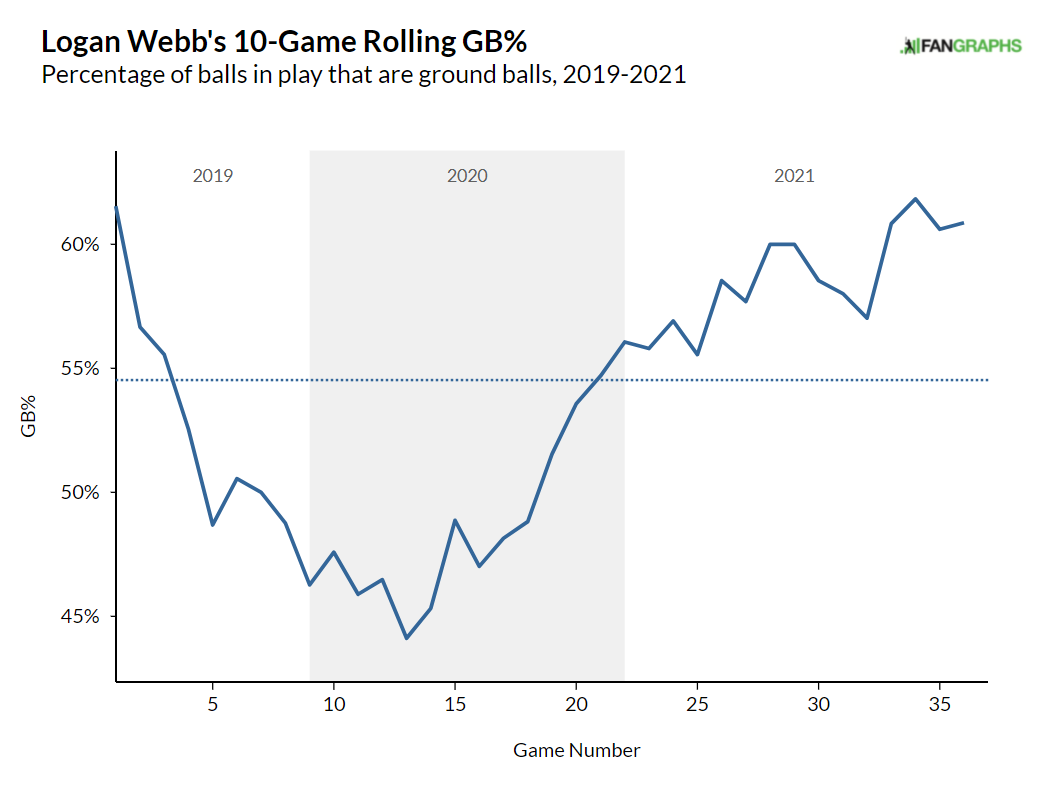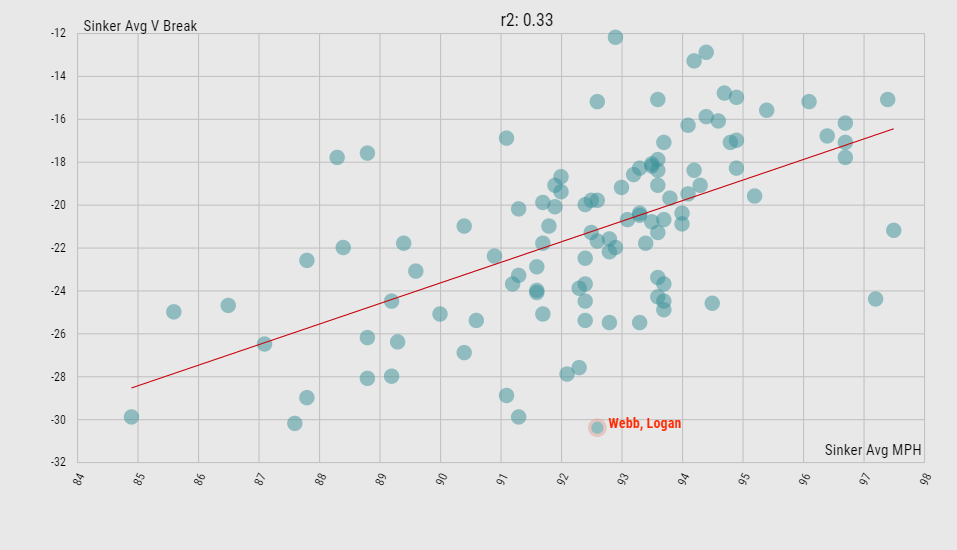Logan Webb Is Sinking His Way to Success
For much of the San Francisco Giants’ wildly improbable 2021 season, the story of their pitching success (they have the third-best ERA and fourth-best FIP in baseball) has centered on a group of revitalized veterans, namely Kevin Gausman, Anthony DeSclafani, Johnny Cueto and Alex Wood, who have pitched better than ever, or at least better than they have in years. The shine on that group has begun to fade in recent weeks, however: the staff ace, Gausman, had a rough July and DeSclafani has struggled recently and now finds himself on the Injured List. Enter Logan Webb, a pitcher much their junior, who couldn’t have picked a better time to get his first taste of big league success.
A fourth round pick back in 2014, Webb moved methodically through a Giants farm system that was struggling to develop starting pitching. Even with the blockades of a 2016 Tommy John Surgery and a 2019 PED suspension, Webb still made his debut in 2019 at 22 years old, making him the youngest Giants starter to debut since Madison Bumgarner did so at age 20 in 2009.
Now 24, Webb is sustaining a high-level of performance in the midst of a pennant race that has the Giants gripping tightly to first place in a stout NL West. He currently boasts an ERA (3.33) more than two runs better than his career mark prior to the season (5.36). He also has the best ERA and FIP in the rotation since July 1 and has given up two runs or fewer in his last eight starts — half of which came against the vaunted Dodgers (three times) and Astros:
| Season | ERA- | FIP- | xFIP- |
|---|---|---|---|
| 2019 | 123 | 97 | 88 |
| 2020 | 126 | 98 | 101 |
| 2021 | 83 | 83 | 74 |
What has led to Webb’s breakout this season? The first thing you may notice is his soaring groundball rate. His 60.3% groundball rate is the third best GB% in baseball among pitchers with 70 innings and it’s a big jump up from his already good rate of 51.8% last year:

Grounders are good for the obvious reason that they can’t be home runs — utter chaos aside — and when you have the still-elite Brandon Crawford patrolling the left side of the infield behind you, things can start to feel unfair for the hitter. On a league-wide level, groundballs have allowed a .218 wOBA this year while Webb’s grounders have allowed a dastardly .185 wOBA. Of course, the .203 BABIP he’s getting away with on grounders likely won’t last but he has also given up especially soft grounders (83.1 mph), so it’s not as if he’s entirely lucking into those results.
Next let’s check out his pitch usage. You’ll can probably begin to hone in on how he’s getting more groundballs:
| Season | Four-Seam | Sinker | Changeup | Slider |
|---|---|---|---|---|
| 2019 | 42.6% (93.3) | 13.8% (92.0) | 20.1% (85.0) | 23.5% (82.0) |
| 2020 | 31.9% (93.2) | 16.5% (91.8) | 30.6% (84.7) | 15.3% (81.5) |
| 2021 | 12.2% (93.3) | 33.5% (92.7) | 26.4% (85.9) | 26.1% (82.5) |
Webb has swapped the usage of his four-seamer and sinker. His four-seamer comes in a little faster and actually has a 75th percentile spin rate, but it has been crushed in his big league career to the tune of a .427 wOBA allowed. His sinker has always been the better of the two pitches and that’s before we even get to the transformation it has undergone this season. You can see in the pitch usage chart that the velocity is up a tick from last season. But more than just velocity, the pitch is dropping more this year as well. On average, his sinker is dropping about three more inches than last year — not an insignificant amount, especially when you factor in the velocity increase.
To get a better idea of where his sinker currently sits compared to the rest of the league, take look at this graph, which plots sinker drop versus velocity:

No starter throws a sinker that drops as much as Webb’s. Fellow sinker fiend Dallas Keuchel gets nearly the same amount of drop but his version comes in 5 mph slower. Other successful sinker ballers like Marcus Stroman and Framber Valdez throw their sinkers about as hard as Webb but at the expense of a couple inches of sink. Webb’s sinker really is unique and it’s been a big reason for his success this season.
As you can imagine, a pitch with that type of profile is hard to get in the air. Webb’s groundball rate on the pitch is 67.6%. Sinkers are designed to get grounders but even still, the league average for sinkers is only 56.1%.
Check out a comparison between Webb’s new sinker and last year’s model:
This season, Webb’s sinker has a sharper bite to it; that pitch to Jose Altuve looks nigh unhittable. On top of improvements to the stuff, he’s also been locating the pitch better — really, he’s located all of his pitches better. He has a career low walk rate and specifically with his sinker, he’s thrown 34% of them at the knees or below, compared to just 28% last season. In total, his sinker has allowed a .313 wOBA so far this season, where .346 is league average for the pitch; in 2020, his sinker allowed nearly that, at .343.
Of course, sinkers can be fickle friends, as hitters just don’t seem to want to swing and miss at them. Webb’s sinker is no exception, with merely a 5% swinging strike rate. It may surprise you to learn then that Webb actually has a career high strikeout rate (24.1%) and whiff rate (10.9%) this season and some changes to the rest of his arsenal are to thank.
First up is his breaking ball. You saw earlier that he’s also throwing it at a career high level and for good reason: it’s been his best pitch by Pitch Value and has induced whiffs 17.9% of the time it’s thrown. Hitters are hitting a measly .132 on his slider (or curve, as you’ll see it described) with a .181 wOBA:
It’s a pitch he has success with against righties (.152 wOBA on 32.8% usage) and lefties (.241 wOBA on 17.2% usage) thanks to it having a bit more vertical drop than a typical slider. Like many of us, however, his breaking ball had a weird 2020, as it performed poorly and didn’t generate whiffs at its normal level — only 8.5%. It was a strange blip for a pitch that was a big part of his success as a prospect and that was the lone bright spot in his rookie season. It’s back now and he has wisely upped its usage to 35% in two-strike counts; prior to this season, he was throwing it less than a quarter of the time in two-strike counts. This is allowing him to put up a near league-average strikeout rate despite throwing his whiff-inept sinker so often.
Webb’s changeup has been the wild card throughout his career, as it often shows flashes of brilliance (see below) but has lacked consistent execution. It sits in the mid-to-upper-80s, a few ticks up from his breaker and about 7 mph slower than his sinker. Just like his sinker, his changeup has the most drop in baseball among changeups as well as abnormally little horizontal movement, making it’s movement profile unique:
It’s really a special pitch to watch when it’s on, as it gets more whiffs (14.3%) than his sinker while maintaining an elite groundball rate of 67.7%. If there is a downside it’s that all that movement seems to make it a bit tough to command as Webb has a tendency to leak it up in the zone and off the plate.
These tweaks to Webb’s arsenal, including more prominently featuring his heavy sinker and swing-and-miss slider, appear to have solidified a three pitch mix that has turned him into a valuable rotation piece for a Giants team with postseason aspirations for this year and beyond. All of the starting pitchers I mentioned earlier are on expiring contracts, or in Cueto’s case, have a team option for one more season. The development of Webb gives the front office a much needed long-term rotation piece that they can continue to build around.
Luke Hooper is a designer and writer at FanGraphs. He lives in Portland, Oregon, longing for a major league team to materialize.

Thanks very much! Webb also has a FB% of only 18.1% (even lower than Tyler Rogers) and a Hard% of 27.1%, so he shouldn’t be giving up many homers, although this HR/FB rate of 16.6% has been messing that up for now. In fact for the whole season he has the lowest xFIP of the Giants’ 5 main starters (3.15). Somehow he’s even gone under the radar of Giants’ fans as well, although that Houston game did catch people’s attention.
Most fans, but most fans are casual fans. They don’t follow the minors or the DSL or the International Signings in other countries…
I’ve been watching him (along with all the others) since he was drafted. It took him a few years to get established while looking like he was going to be a #5, at best, starter. In 2019 he really picked it up and looked like he might be mid-rotation.
But this spring he was amazing. Then went to hell when the season started and I, like so many of us, was really wondering if he was going to make it he was just a Spring Training Wonder.
But after his rough April and he recovered. Then IL. And now he’s back and pitching like he wants to the anchor man on this rotation. And he’s just 24 which is fantastic.
He has not gone under the radar of Giants fans. Not sure what your basis for saying that is but it is absolutely laughable.
The great majority of Giants ‘ fans are still talking like Gausman and deSclefani are the aces of the staff and the others are basically competent.